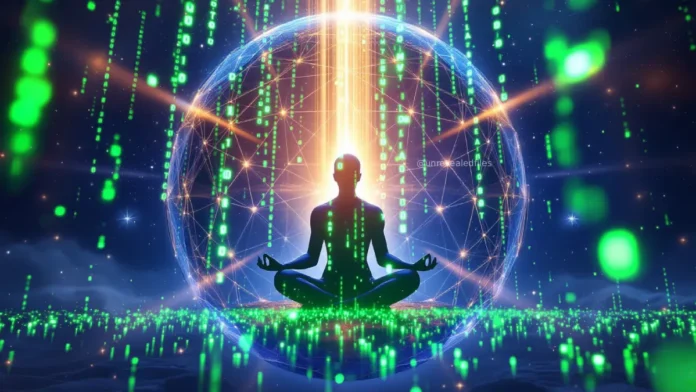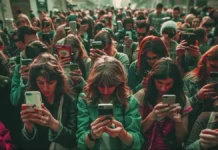
Contents
The Simulation We Call Life
What if the world we see, touch, and believe to be real is just an illusion? This question has haunted philosophers for centuries, but in Indian philosophy, it is not just a question; it is an accepted truth. Known as Maya, this principle describes the world as a cosmic projection, a dream-like experience that appears real but conceals a deeper, ultimate reality.
Today, with the rise of virtual reality, artificial intelligence, and even the simulation hypothesis proposed by modern philosophers, Maya feels more relevant than ever. It invites us to rethink not just what reality is, but who we are. And interestingly, this ancient insight finds a perfect modern metaphor in pop culture, The Matrix, which portrays humanity trapped in a computer-generated world.
The Nature of Maya
In Sanskrit, Maya literally means “that which is not what it seems.” It is the power of illusion, but not in a trivial sense. Maya is the cosmic fabric of experience, woven by consciousness itself. It gives rise to the multiplicity of forms, time, and space, concealing the eternal unity of all existence.
In Advaita Vedanta, Maya is the veil that covers Brahman, the formless, infinite, and unchanging ultimate reality. Our senses, mind, and ego interact with this veil, mistaking the temporary for the eternal. As a result, we live in a kind of cosmic simulation, unaware that the truth lies beyond appearances.
Maya Across Dharmic Traditions
Vedanta: The Illusion of Duality
Vedanta teaches that the self (Atman) is not separate from Brahman, yet Maya creates the illusion of duality, of subject and object, self and other, joy and sorrow. Moksha, or liberation, is the moment we awaken from this dream and recognize that all distinctions are transient.
Buddhism: The Emptiness of Phenomena
Buddhism echoes this view but frames it in terms of Shunyata (emptiness). Phenomena arise interdependently and have no fixed essence; much like waves on an ocean, they come and go but do not define the sea itself. Awakening to this insight leads to Nirvana, freedom from the endless cycle of Samsara.
Jainism: The Veil of Attachment
Jain philosophy sees Maya as Mithya, false perception clouded by attachment and karmic accumulation. Through ethical living, self-discipline, and detachment, the soul gradually clears the fog of illusion and perceives reality as it truly is.
Maya as Simulated Reality
Modern philosophy and science have caught up with this ancient insight. Think of virtual reality: you put on a headset and suddenly you are in a world that looks and feels real, yet it is entirely constructed. Maya works the same way, but on a cosmic scale.
Philosopher Nick Bostrom’s simulation hypothesis even suggests that our universe could be a sophisticated digital simulation. If true, then our “real world” is just as illusory as the Matrix, a startling confirmation of what the Upanishads taught thousands of years ago.
The Upanishadic Prayer: Humanity’s Red Pill
One of the most beautiful expressions of the human longing to break free from illusion is found in the Bṛhadāraṇyaka Upaniṣad (1.3.28):
ॐ असतो मा सद्गमय ।
तमसो मा ज्योतिर्गमय ।
मृत्योर्मा अमृतं गमय ।
Translation:
“Oṁ, lead me from the unreal to the real,
Lead me from darkness to light,
Lead me from death to immortality.”
This is not just a prayer; it is a roadmap. It urges the seeker to move from illusion to truth, from ignorance to enlightenment, from the cycle of birth and death to eternal freedom.
And remarkably, this journey is mirrored in one of modern cinema’s greatest allegories: The Matrix.
The Matrix: A Modern Parable of Maya
At its heart, The Matrix is a story about Maya. The world Neo lives in is a computer simulation, beautiful but false, comforting yet enslaving. When Morpheus offers him the red pill, Neo is given the choice to awaken.
- From Unreal to Real: Neo literally steps out of the false world into the real one, echoing “असतो मा सद्गमय.”
- From Darkness to Light: His first experience of truth is painful; his eyes hurt because, as Morpheus says, “You’ve never used them before.” This is the spiritual shock of awakening, the painful brightness of truth after lifetimes of ignorance.
- From Death to Immortality: Neo eventually transcends the rules of the Matrix, becoming “The One.” He no longer fears death, bullets cannot harm him, symbolizing liberation from the cycle of Samsara.
The Matrix shows us that Maya is not just a philosophical abstraction; it is the story of every seeker who chooses truth over comfort, reality over illusion.
Ethical and Spiritual Implications
Understanding Maya is not about rejecting the world; it is about seeing it clearly. When we know it is an illusion, we stop clinging to its fleeting pleasures and pains.
- Detachment: We act without attachment to results, as the Bhagavad Gita teaches.
- Compassion: We treat others kindly, knowing they are also navigating the same dream.
- Awareness: We strive to wake up, to see beyond appearances and discover our true nature.
Maya in Contemporary Thought
Neuroscience tells us our brain is not a passive receiver of reality but an active constructor of it, a biological VR headset. Psychology teaches that our perceptions are shaped by biases and conditioning, another layer of Maya. Even AI-generated content blurs the line between real and artificial, forcing us to question what is authentic.
In other words, the conversation about Maya has never been more urgent.
Conclusion
Maya is not an enemy; it is a teacher. It challenges us, deceives us, and ultimately pushes us toward awakening. Whether we look to the Upanishads, the Buddha’s teachings, or The Matrix, the message is the same:
Reality is not what it seems.
The truth lies beyond the veil.
Our highest calling is to wake up.
The journey from illusion to truth, from darkness to light, from death to immortality, is the oldest and most profound story ever told, and we are all living it right now.
Sources
- Rajagopal, S. “The Spiritual Philosophy of Advaita: Basic Concepts and.” PMC, 2024. PubMed Central.
- Satapathy, D. R. The Doctrine of Māyā in Advaita Vedānta. Punthi-Pustak, 1992.
- Whitehead, J. “The Philosophies of Sankara, Ramanuja and Madhva.” University of Pretoria Repository, 2019.
- “Om Asato Ma Sadgamaya.” Green Message.
- “Lead Us from Untruth to Truth: Asatoma Sadgamaya.” Amritapuri.
- Krishnananda, Swami. The Brihadaranyaka Upanishad – Discourse 8 (PDF). Swami Krishnananda.org.
- Chalmers, David J. The Matrix as Metaphysics. 2003.
- Pryor, James. “What’s So Bad about Living in the Matrix?” Jim Pryor’s Philosophy Papers.
- Falkenrath, O. G. “Free Will vs. Determinism in The Matrix: Metanarrative Implications.” JRSSH, vol. ?, 2024.
- “Breaking Down the Philosophy of ‘The Matrix’ Trilogy.” No Film School.
FACT CHECK: We strive for accuracy and fairness. But if you see something that doesn’t look right, please Contact us.
DISCLOSURE: This Article may contain affiliate links and Sponsored ads, to know more please read our Privacy Policy.
Stay Updated: Follow our WhatsApp Channel and Telegram Channel.











